
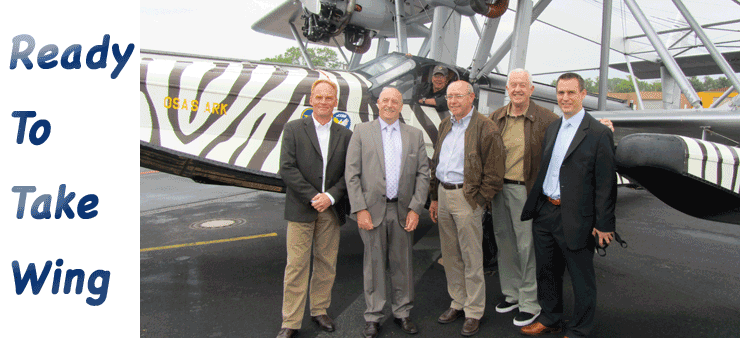
Volker Dunkake, LH Cargo Charter, Bernd Grün, Geodis Wilson Germany,
Ulrich Brenner KN Airlift, Geoffrey Arend, Air Cargo News FlyingTypers,
Nils von Buxhoeveden, LH Cargo Charter, and the pilot with the plan and
plane—Thomas Schrade.
The flight was more a smoke
dream than any reality, an out of body experience suspended between reality
and imagination: we were flying above Germany, traveling from Frankfurt
to Darmstadt in a tiny, vintage 1920s aircraft.
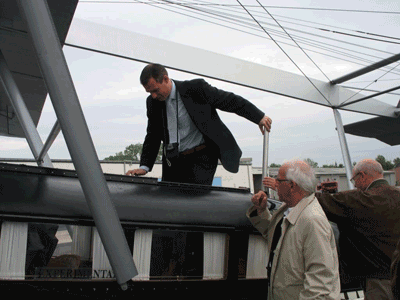 Our
cabin was shaped like a small boat and lined with wood and wicker chairs.
From inside, we could look out at roaring, twin reciprocating piston engines
attached to a 70-foot wide wing, amidst a cacophony of wires and struts
that cradled and lifted our aerial boat aloft. Our
cabin was shaped like a small boat and lined with wood and wicker chairs.
From inside, we could look out at roaring, twin reciprocating piston engines
attached to a 70-foot wide wing, amidst a cacophony of wires and struts
that cradled and lifted our aerial boat aloft.
Up and away into the wild blue yonder we
flew, dancing in and out of the clouds and up through the sky at an unfathomable
height – have you ever had dreams where you could fly all on your
own, despite the limitations of your flightless body? Those dreams where
you can see everything happening on the ground, where you never fly so
high that your passing doesn’t cause the grass to bend underneath
you? Aloft, but still tied to the earth. That was what it was like. From
the S-38 we could clearly observe activity on the ground; wash being hung
on a backyard clothesline, neatly manicured farms and herds of sheep and
cattle, stranded motorists on a jam-packed spur of Autobahn. All these
sights slipped by under our gaze, almost at our fingertips.
I kept thinking that if this were Sunday
and not Wednesday, we might have seen the now empty parking lots around
town churches full of cars and the Autobahn less busy.
No one that has spent any time around an airplane can deny the stuff of
legend and lore as history came alive Wednesday.
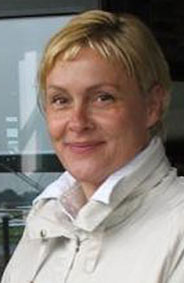 Nina Lamprecht, Chief Information
Officer at Frankfurt Egelsbach Airport, is both beautiful and animated
about her gateway, which records 85,000 aircraft movements yearly,
and with just 23 staff.
Nina Lamprecht, Chief Information
Officer at Frankfurt Egelsbach Airport, is both beautiful and animated
about her gateway, which records 85,000 aircraft movements yearly,
and with just 23 staff.
“We do what we do," says
Nina, who once upon a time worked for Pan Am.
"Our airport is the perfect host
for fliers and aviation romantics - it's also great for those who
want to come and watch the world go by and enjoy a wonderful meal
in our restaurant.
“I loved the S-38, especially
the garden chair (wicker) seats aboard the craft.
“A bit bumpy but thoroughly
exciting and wonderful.”
|
We were at
Egelsbach Airport, an FBO base near Frankfurt Am Main, Germany, where
Netjets operates and Lufthansa’s JU-52 is based, and a fabulous
restaurant that brews its own beer is joined by vintage aircraft that
fly in every so often for a day, offering joy rides to the locals.
This day, September 9, 2010, we were aboard
the only Sikorsky S-38 still in the air. Pilot Tom Schrade flew the lovingly
recreated vintage cargo and passenger aircraft into Germany all the way
from Minnesota to raise money for the charity group “Wings of Help.”
“Osa’s Ark,” painted in
zebra stripes to honor and respect the S-38 filmmakers/authors Osa and
Martin Johnson, who once upon a time flew a similar aircraft in Africa
on various wildlife expeditions during the 1930s, stopped traffic dead,
while on the ground and flying above this vest pocket-sized aviation facility.
Even Lufthansa’s vaunted 1934 Junkers
JU-52 “Templehof,” which remains a main attraction here and
flies sightseers, romantics and thrill-seekers regularly, crew-tipped
a wing in salute to the elder S-38.
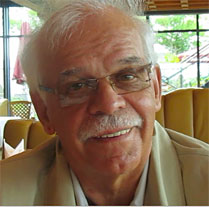 “Wings
of Help” boss Frank Franke, (left) who is otherwise occupied 24/7/360
raising money to send emergency help around the world, was caught up in
the moment as he sang the praises of Pilot Tom Schrade, who he says, ”is
one of a kind.” “Wings
of Help” boss Frank Franke, (left) who is otherwise occupied 24/7/360
raising money to send emergency help around the world, was caught up in
the moment as he sang the praises of Pilot Tom Schrade, who he says, ”is
one of a kind.”
But Herr Franke, who carries a definite
sense of dedication and purpose, set aside any consideration except the
plight of the hopeless and also raised money to sponsor the S-38 trans-Atlantic
adventure by selling miles to people from all over the world.
“Some sponsored one mile of the S-38
journey from USA to Germany,” Herr Franke said.
“Others reserved 500 and 1,000 miles.
“Some of the money raised, including
a very generous sponsorship from Lufthansa Charter, is being applied immediately
next week with a relief flight to help people in Pakistan, while here
in Europe we have scheduled another flight of supplies to Romania where
the need for help continues.”
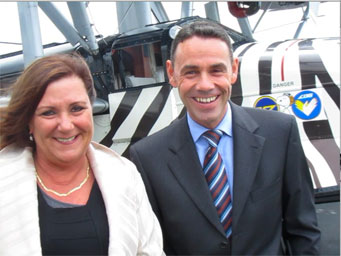 Reto
Hunziger, Manging Director Lufthansa Cargo Charter and Heide Enfield,
Head of Marketing & PR. Reto
Hunziger, Manging Director Lufthansa Cargo Charter and Heide Enfield,
Head of Marketing & PR.
“Wings of Help is a great charity
that is constantly at crises points everywhere in the world with special
emphasis in helping children. Next week as example, Wings has organized
and provided the movement of tons of disposable diapers to Pakistan, as
unimaginably severe flooding continues to challenge every facet of life
in that country.
Lufthansa Charter is proud to support Wings of
Help.”
Apropos of the
Egelsbach S-38 flight date of September 9, 2010 – it was exactly
82 years ago to the day that Charles Lindbergh departed Miami Airport
on September 9, 1928, piloting a Pan Am S-38 to Havana, Cuba, the first
U.S.A. Air Mail to fly across the route.
“It’s been a great ride and
something I’ll think about for many years,” said Volker Dunkake
of Lufthansa Charter.
“It was also special to ride up front
in the right seat.
“Since we used road maps and I know
the country around here, I guess my local knowledge made me navigator
for a day,” Volker smiled.
Later, the S-38 departed for Jersey and
an end-of-summer aviation show, right after the BP Avgas truck topped
off each of the S-38s tanks.
Tom Schrade, who is just as regular as your
best fitting shoes, with an easy smile and a flight jacket that says,
simply, “S-38 Pilot” on the front, handled the Av Gas filling
chores and the accounts payable with his Amex card.
“I’m glad I did not have to
use 5-gallon cans and chamois for a filter as was the norm during the
early days of flying these aircraft,” Pilot Tom said.
Later, Pilot Tom Schrade skipped a celebratory
luncheon held inside the Egelsbach Terminal in a place called, Schuhbeck’s
Check Inn which may be the best airport restaurant in the world with delicious
fish, fowl and meat courses carefully prepared and elegantly presented
by world famous chef Alfons Schuhbeck.
Instead, he said his goodbyes, tossed his
gear and some sandwiches in the rear hatch of the Sikorsky, and taxied
out to the main runway for departure.
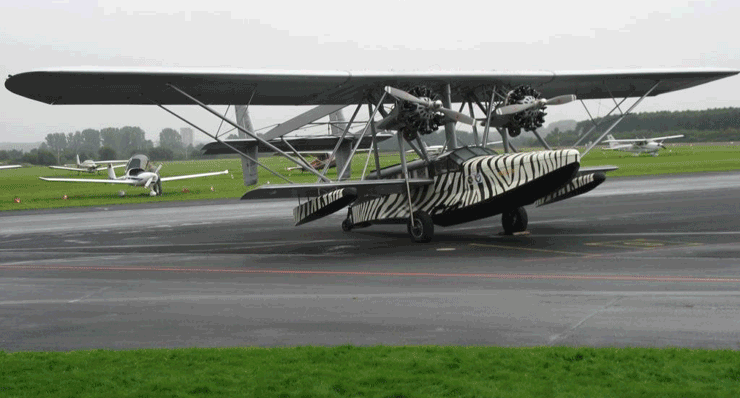 |
The last
look we had at the legendary S-38 aircraft as it banked in the air, turned
and headed for the coast was a flash of the bright “international
orange” paint applied to the upper wing surfaces of the aircraft.
The painted upper wing was standard for
all the great flying boats – The Sunderland’s, The D0-X, The
Boeing 314, Martin China Clipper and every Sikorsky including all the
S-40, 42, 43 and of course the 101 S-38s.
The bright paint served as a beacon for
airplanes that doubled as boats so that spotter aircraft could locate
a flight that wound up a bit short of land during an era of less dependable
engines and no GPS.
But today in 2010, Pilot Tom Shrade’s
S-38 is the only flying boat of all those aircraft still operating, and
while all are gone with little more than flinty black and white newsreel
film and some publicity pictures to attest that they ever existed, Pilot
Tom says he expects to stay on the wind, maybe fly down to Africa, maybe
even across the short route to Brazil before returning to Minnesota “as
long as I can find some gas.”
 |
Contact: Wings
of Help Donation account: Frankfurter Sparkasse, Account No. 200 33
22 44, Routing No. 500 502 01.
Geoffrey/Flossie |




 “Wings
of Help” boss Frank Franke, (left) who is otherwise occupied 24/7/360
raising money to send emergency help around the world, was caught up in
the moment as he sang the praises of Pilot Tom Schrade, who he says, ”is
one of a kind.”
“Wings
of Help” boss Frank Franke, (left) who is otherwise occupied 24/7/360
raising money to send emergency help around the world, was caught up in
the moment as he sang the praises of Pilot Tom Schrade, who he says, ”is
one of a kind.” Reto
Hunziger, Manging Director Lufthansa Cargo Charter and Heide Enfield,
Head of Marketing & PR.
Reto
Hunziger, Manging Director Lufthansa Cargo Charter and Heide Enfield,
Head of Marketing & PR. 

